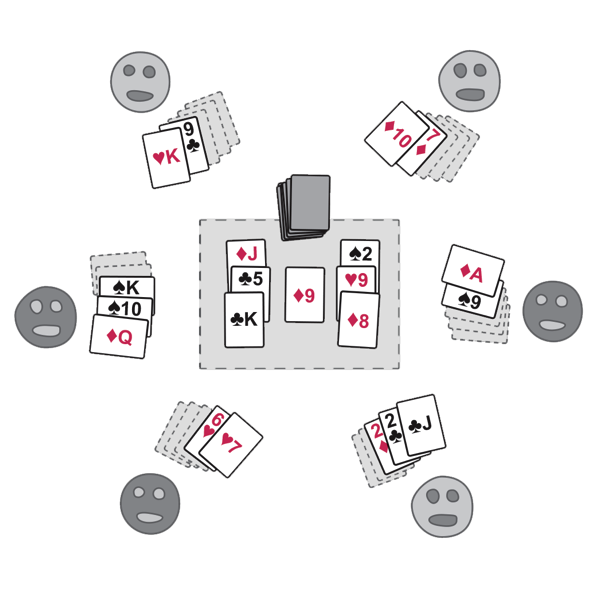-
RULES
REQUIREMENTS
2 - 9 players. (8 players at max, if cards are ‘burned’.)
A normal deck of 52 playing cards, no jokers.
Poker chips (betting version), or simple bookkeeping equipment (no betting).
A basic knowledge of how poker works.
LAYOUT & POKER HAND
In the center of the table is the community center (1 card) and alongside it will be built two communal towers (holding 3 cards each).
The final poker hand of each player consists of the following 5 cards:
- The remaining 2 or 3 hand cards,
- 1 card from each communal tower, and
- The community center card if dropped 3 cards away (= has only 2 hand cards left).
STARTUP
The game repeats a simple COMMUNITY-PLAYERS-BET -rhythm all throughout. The game starts by:
- COMMUNITY: First one card is dealt face up onto the middle of the table - this is the community center.
- PLAYERS: Each player is then dealt 5 hand cards.
- BET: Finally a traditional poker betting round is played, including the option to ‘fold’ (= choose not to participate in this pot) by discarding all hand cards.
PROGRESSION
The same rhythm is then repeated 3 times to build the communal towers and get rid of a few hand cards:
- COMMUNITY: Both communal towers are dealt 1 card face up. (Optionally the top card of the deck is ‘burned’ before building them.)
- PLAYERS: Each player then discards 1 hand card without showing it. On the 3rd time dropping is optional: each should end up with 2 or 3 hand cards.
- BET: And finally a new poker betting round is played.
POKER HAND & SHOWDOWN
Finally, it's 's time for showdown. The remaining players show their hand cards, and the players’ poker hands are evaluated according to the hand ranking system of choice.
- DEFAULT RANKING: Straight flush > 4 of a kind > Full house > Flush > Straight > 3 of a kind > 2 pairs > pair > high card.
After the hands are evaluated, the winner collects the pot - or for non-betters, the points are counted.
-
-
VARIANTS
SCORING BY WINNING / LOSING
At its simplest, you can just count the number of won pots. The winner is the first one to win 5 pots.
- Alternatively, you could reward the winner with 2 win-points and the second best with 1 win-point and play until 10 win-points.
- This works well with high-low-splits: The highest hand gets 2 win-points and the lowest hand 1 win-point.
SCORING BY POINTS
A little bit more complicated way is to use a point system (= absolute points per hand).
- For example, the American point system for Poker Squares / Solitaire goes from 2 points (one pair) to 100 points (Royal Flush).
- The game ends either after a predefined number of pots, or after reaching the point limit.
Here is a simple high-lowish point system called Straight-Up-or-Die. (Play until 15 points is reached.)
- STRAIGHT-UP: Straight: 1p. Flush: 2p. Full-house: 3p. Four of a kind: 4p. Straight-flush: 5p.
- OR-DIE: If no one gets a straight or higher (a straight-up), the worst hand gets 5p. and the 2nd worst 2p. (while others get nothing).
LOWBALL VARIATION (6 hand cards)
When playing normal poker or high-low splits, the setup above is recommended.
When playing lowball (lowest hand wins), the below variation is recommended:
- Each player is dealt 6 hand cards (1 extra).
- The players must always drop a hand card (so they always end up with 6 - 6 = 3 cards).
- The player’s poker hand consists of 6 cards: The 3 hand cards, the community center, and 1 card from each tower.
Other implications:
- Ace-to-six is recommended - rather than ace-to-five, where straights and flushes are ignored.
- Consequently the maximum number of players is 7 players (with or without burning cards).
- Note: Sometimes a community pair might save you from a (lower) pair you would otherwise have (with your hand cards).
ABOUT DIFFERENCES & STRATEGY
This poker variant has some essential differences when compared to other forms of poker (for example, Texas Hold’em):
- NARROWING OF CHOICES: You must choose (3 times) the appropriate path to follow - that is, which card to discard (or which not to).
- HIGH HANDS MORE OFTEN: You are more likely to get straight-flushes, full-houses and other 'fun hands'.
- BLUFFING BY PLAYING CARDS: Bluff your opponents by your choice of discarding / not discarding a hole card (on the last round). Not just talk & such.
- SUDDEN SURPRISES: As 2 new cards arrive each cycle, the situations may change quickly. (So get rid of your opponents early enough.)
-
-
THANKS
FOR IDEAS, HELP WITH DEVELOPMENT & PLAYING
To the various unknown developers of poker, especially the Texas and Omaha hold'em variations.
